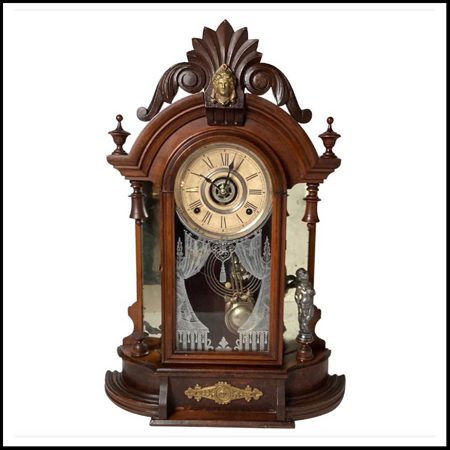The turn of the last century was the last hurrah of the great American mantel clock makers. Who were these manufacturing powerhouses of American antique mantel clocks? Let’s find out.
Ansonia was probably the largest and most successful, followed by Gilbert, Seth Thomas, Waterbury, Ingraham, New Haven, and E. N. Welch.
The Mantel Clock Makers
The turn of the last century marked the zenith of American mantel clock manufacturers, with several companies standing out as manufacturing powerhouses in this space. These companies played a significant role in shaping the history and legacy of American mantel clocks. Let’s take a closer look at some of these prominent manufacturers:
The Ansonia Clock Co.: A Legacy of Timekeeping Innovation
Ansonia, the largest and most successful American antique clock manufacturer, was renowned for producing high-quality mantel clocks, with most notable of them, the “Crystal Regulators”. The company’s designs and craftsmanship set a standard for excellence in the industry. Many of their competitors created and sold copies of the Ansonia mantel clock line. Some of the hallmarks of their lineup were the Apex, The Regal, The Marchioness, and The Viscount among others.
The Ansonia Clock Company, a name synonymous with American clockmaking, left an indelible mark on the history of timekeeping. From its humble beginnings in the late 19th century to its eventual decline in the early 20th century, Ansonia’s journey is a testament to the rise and fall of American industrial ambition.
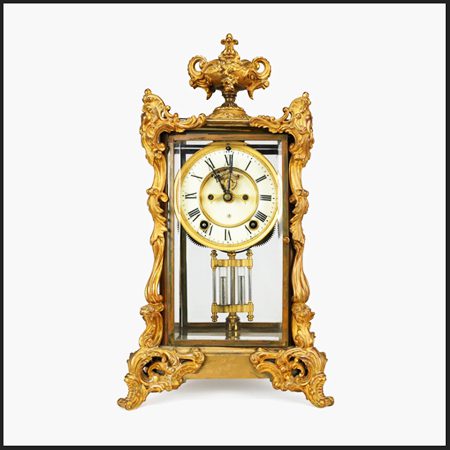
Founded in 1850 by Thomas Wallace Ansonia, the company initially focused on producing brass goods. However, the advent of the Industrial Revolution and the demand for affordable timepieces saw Ansonia pivot towards clockmaking. By the 1870s, Ansonia had become a major player in the American mantel clock market, renowned for its innovative designs and mass-production techniques.
Despite its early success, Ansonia faced challenges in the later part of the 20th century. The rise of cheaper clock imports from Europe and the increasing popularity of wristwatches led to a decline in demand for traditional clocks. This, coupled with inefficient management practices, ultimately led to the company’s closure in 1929.
Gilbert Mantel Clock Company
Gilbert was another major player in the American mantel clock industry. With a strong reputation for both design innovation and precision engineering, Gilbert’s clocks were highly sought after during this era.
The Gilbert Clock Company was founded in Winsted, Connecticut, in 1828 by William L. Gilbert. It initially started as a manufacturer of wooden clock cases and components. However, in the late 19th century, the company shifted its focus to producing complete clocks.
Gilbert Clock Company became known for its high-quality clocks, and it gained popularity across the United States. The company manufactured various types of clocks, including mantel clocks, wall clocks, and alarm clocks. They also produced clock movements, which other clock manufacturers used.
The company went through a few ownership changes over the years. In 1964, they merged with the rival company, the Sessions Clock Company, to form the company known as “Gilbert-Sessions.” However, the merged company only lasted for a few years before both brands ceased production.
Today, Gilbert clocks are considered collectibles, and antique Gilbert clocks can still be found in homes and exhibitions. They are highly sought after by collectors due to their craftsmanship and historical significance.
Seth Thomas, Riveling Ansonia in Size
Seth Thomas, a name synonymous with quality and craftsmanship, played a pivotal role in shaping the American mantel clock landscape. From the mid-19th century onwards, the company, founded by Thomas himself, became a household name, producing clocks that graced countless homes and epitomized the era’s aesthetic sensibilities.

Seth Thomas’s success stemmed from his commitment to producing American mantel clocks that were both aesthetically pleasing and functionally reliable. The company embraced a wide range of styles, catering to diverse tastes and budgets. From the ornate and intricate Victorian designs to the simpler, more functional styles of the early 20th century, Seth Thomas clocks offered something for everyone.
Seth Thomas and Riveling Ansonia American mantel clocks played a vital role in the American home, from the humble farmhouse to the stately mansion. They were more than just timekeepers; they were symbols of status, style, and the enduring spirit of American craftsmanship. As you admire a vintage Seth Thomas or Riveling Ansonia clock today, remember these two giants’ rich history and enduring legacy in the American antique mantel clock landscape.
Waterbury Clock Company
The name Waterbury has long been synonymous with quality and craftsmanship in the world of horology. Founded in 1857, the Waterbury Clock Company carved a prominent niche in the American clockmaking scene, particularly with its exquisite mantel clocks. These timepieces, renowned for their elegance and reliability, graced countless homes and became cherished heirlooms passed down through generations.
Waterbury’s success stemmed from several key factors. Firstly, the company embraced innovation, pioneering the use of mass production techniques while maintaining high standards of quality. This allowed them to offer affordable yet beautifully crafted clocks to a wider market. Secondly, their designs were both stylish and functional, incorporating intricate details like ornate carvings, polished brass accents, and elegant Roman numerals.
The company’s catalog boasted a wide array of mantel clocks, each catering to different tastes and budgets. From simple yet elegant designs with traditional Roman numerals to more elaborate pieces featuring intricate carvings and decorative elements, Waterbury offered a clock for every home. They even produced a line of ‘skeleton’ clocks, showcasing the intricate inner workings of the timepiece through an open face.
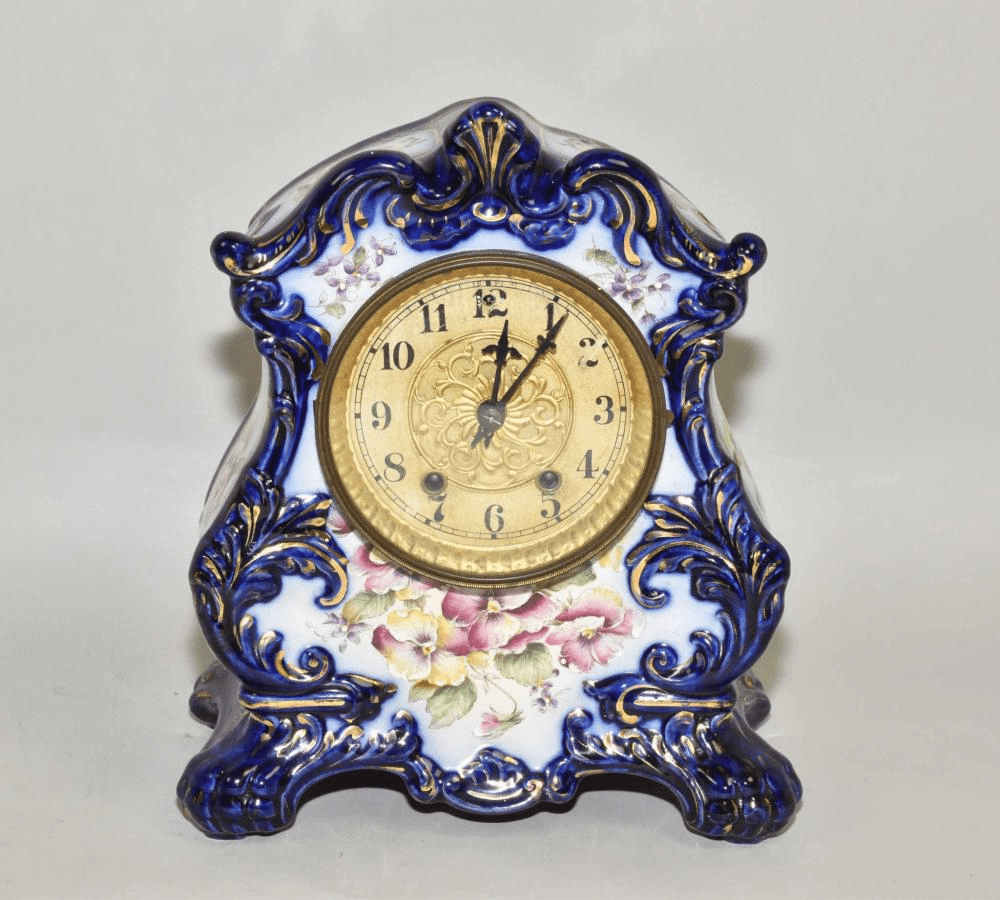
Despite facing challenges in the face of changing market trends and technological advancements, Waterbury remained a prominent force in the clockmaking industry for over a century. Their legacy lives on in the countless mantel clocks that grace homes and museums worldwide. These timepieces, not only functional but also beautiful works of art, stand as a testament to the artistry and craftsmanship of the Waterbury Clock Company, forever reminding us of the importance of time and the enduring allure of a well- crafted clock.
Ingraham American Mantel Clock Co.
The Ingraham Clock Company, a name synonymous with American craftsmanship and innovation, left an indelible mark on the world of timekeeping, particularly in the realm of mantel clocks. Founded in 1852 by Charles Ingraham, the company flourished for over a century, captivating homes with its distinctive blend of traditional artistry and progressive design.
Ingraham’s success rested on its ability to capture the pulse of the times. While the company initially focused on manufacturing affordable, efficient clocks, it quickly recognized the growing desire for decorative pieces that enhanced the home’s aesthetic. This led Ingraham to embrace a diverse range of styles, from the classic and elegant to the ornate and whimsical, ensuring a clock for every taste and budget.
The company’s mastery of craftsmanship was evident in the intricate details of its clocks. Intricately carved wood frames, hand-painted faces, and meticulously crafted movements showcased the dedication and skill of Ingraham’s artisans. The American mantel clock became more than mere timekeepers; they were miniature works of art, meticulously crafted to adorn the mantelpieces of the era.

The Ingraham Clock Company’s impact on the design of mantel clocks was profound. The company’s distinctive blend of traditional craftsmanship and forward-thinking design shaped the aesthetic of the period, inspiring countless other manufacturers and influencing the evolution of clock design for generations to come.
Today, these vintage Ingraham clocks stand as a reminder of a bygone era, when time was not merely measured but meticulously crafted into works of art, each tick a testament to the Ingraham Clock Company’s enduring contribution to the history of timekeeping.
New Haven Clock Company
Nestled in the heart of New Haven, Connecticut, the New Haven Clock Company emerged as a shining star in the realm of horology, renowned for its exceptional craftsmanship and unwavering commitment to precision timekeeping. From its humble beginnings to its rise as a leading mantel clock manufacturer, New Haven has left an indelible mark on the history of timepieces.
The New Haven Clock Company was founded in 1853 by two enterprising businessmen, Andrew S. Hotchkiss and Henry H. Benedict. Initially, the company focused on producing traditional wooden clocks, but in the 1870s, it shifted its attention to the burgeoning market for mantel clocks.
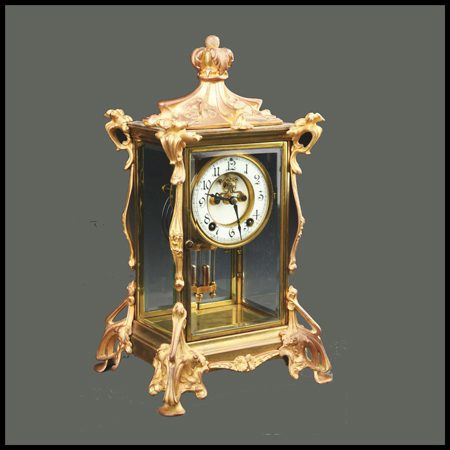
Under the leadership of George M. Bartholomew, the company’s chief designer, New Haven introduced a series of groundbreaking innovations that revolutionized the industry. In 1885, it unveiled the ‘Self-Adjusting Pendulum,’ which automatically compensated for temperature variations, ensuring accurate timekeeping regardless of the season.
New Haven clocks were not only renowned for their precision but also for their exquisite designs. The company collaborated with renowned artists and designers to create American mantel clocks that were both functional and aesthetically pleasing.
One of the most notable collaborations was with Louis Comfort Tiffany, the renowned glass artist. Together, they produced a series of clocks adorned with Tiffany’s signature stained glass windows, which added a touch of elegance and sophistication to any room.
By the turn of the 20th century, New Haven had established itself as a dominant force in the mantel clock market. Its clocks were known for their impeccable craftsmanship, stylish designs, and reliable timekeeping.
New Haven clocks came in a wide variety of styles, from intricate Victorian to Art Deco. Each clock was meticulously crafted using high-quality materials, such as brass, marble, and porcelain.
E. N. Welch
Beyond aesthetics, E. N. Welch prioritized technological advancement. The company incorporated innovative features into their clocks, such as:
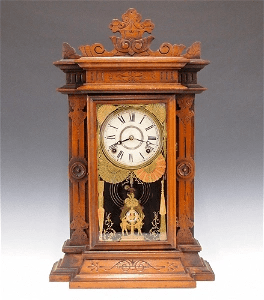
Improved movements: Welch’s clocks boasted robust and reliable movements, often utilizing high-quality materials and precise engineering. These movements ensured accuracy and longevity, ensuring the clocks continued to tick for generations.
Unique chime systems: From the traditional Westminster chime to more elaborate melodies, Welch’s American mantel clock line offered a variety of chime options, adding a delightful auditory dimension to their beauty.
Novel materials: The company experimented with various materials, including fine woods, brass, and even porcelain, showcasing their commitment to innovation and pushing the boundaries of clockmaking.
The impact of E. N. Welch extended beyond the realm of clocks. The company’s dedication to quality and innovation inspired other American mantel clock manufacturers and helped elevate the status of mantel clocks from mere functional devices to cherished pieces of furniture and art.
In conclusion, the turn of the last century saw these manufacturing powerhouses play a vital role in shaping the American mantel clock landscape, leaving a legacy that remains influential in the world of horology.



